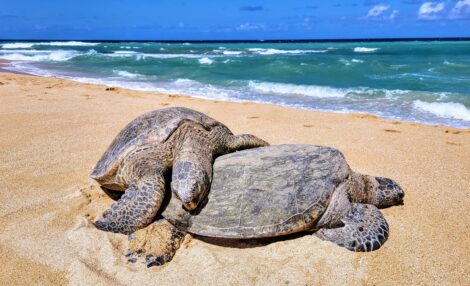U.S. agency: Keep threatened status for turtles
Federal wildlife officials propose keeping Hawaii’s green sea turtles’ threatened status under the Endangered Species Act, meaning it would continue to be illegal to kill or hunt them.
Hawaii has a population of fewer than 4,000 nesting sea turtles, nearly all of which nest on a low-lying island in the French Frigate Shoals in the Northwestern Hawaiian Islands, officials said.
Friday’s announcement from the National Oceanic and Atmospheric Administration and U.S. Fish and Wildlife Service comes approximately three years after the Association of Hawaiian Civic Clubs petitioned the government to study whether Hawaii’s green sea turtles might have recovered to the point where they no longer need federal protection.
But Hawaii’s turtles are vulnerable to disease, rising sea levels and other threats, said Patrick Opay, the endangered species branch chief of NOAA’s Fisheries Pacific Islands Regional Office.
“You have all of your eggs in one basket, so to speak,” he said.
Green sea turtles nest on beaches and feed in the ocean, eating mostly sea grass and algae. Every two to four years, adult females return to the same beaches where they were born to lay eggs, sometimes migrating hundreds or thousands of miles.
At the time of its 2012 petition, the Association of Hawaiian Civic Clubs said delisting Hawaii’s turtles would return management of the animals to the state and allow more people in the islands to take an active role in taking care of them.
The association cited 2007 data showing Hawaii’s population of green sea turtles had been growing at an annual rate of 5.7 percent for three decades. The latest review showed a 4.8 percent annual growth rate.
The civic association is disappointed the agencies aren’t proposing to delist the population, association President Annelle Amaral said.
People who fish, harvest seaweed and otherwise rely on the ocean to feed their families report that the turtle populations have grown so much the animals are moving inland – to places like the Hanalei River – to forage for food, Amaral said. She’s heard that some areas are overpopulated with turtles, she said.
Hannah Bernard, president and co-founder of the Hawaii Wildlife Fund, said federal officials propose reclassifying sea turtles into 11 distinct population segments, since turtles in the same patch of ocean – the Hawaiian archipelago, for instance, share a genetic heritage and are isolated from other groups by vast expanses of ocean.
In Hawaii, sea turtles forage among the main islands, but nest in the northwestern islands, she said.
“They’re true kamaaina. They’re keiki o ka aina,” Bernard said.
The turtles remain in their region and don’t migrate long distances, she said.
The turtles’ designation as a distinct population, with the help of DNA testing, allows for special wildlife management, she said. For example, knowing the particulars about a specific population area helps wildlife officials better manage and protect the species. “We’re more focused on our specific populations,” she said.
If there were, for instance, a petition to take a certain number of turtles for subsistence consumption or for a cultural reason, managers could look at the numbers and see if that would work.
“It protects this particular population from being over-harvested,” Bernard said. “It’s a tool that allows a regional level of management.”
In their announcement, federal officials said that “identifying distinct population segments across the green sea turtle’s range would provide the flexibility necessary to help individual populations based on localized threats. NOAA and our partners continue to study green sea turtles to ensure that our conservation and management decisions are driven by the best possible science.”
Meanwhile, officials are proposing to move green sea turtles in waters off Florida and Mexico from “endangered” to the lesser “threatened” status because their numbers are recovering, according to the announcement.
“Successful conservation and management efforts have, in effect, improved the listing status of two breeding populations of green sea turtles from endangered to threatened. This is an important step in building resilient ocean ecosystems,” said Eileen Sobeck, NOAA assistant administrator for fisheries.
But federal agencies believe turtles in American Samoa and the Commonwealth of the Northern Mariana Islands, which were considered threatened before, should now be classified as endangered.
A 90-day comment period has started for members of the public to address plans for sea turtle designations. The deadline for comments is June 22.
Officials have scheduled an April 8 public hearing in Honolulu.
Comments may be submitted to www.regulations.gov/#!docketDetail;D=NOAA-NMFS-2012-0154. Those making submissions should click on the “Comment Now!” icon, complete required fields and attach comments. Mail also may be sent to Office of Protected Resources, NOAA Fisheries, 1315 East-West Highway, Silver Spring, Md. 20910; or Green Turtle Proposed Listing Rule, U.S. Fish and Wildlife Service, North Florida Ecological Services Office, 7915 Baymeadows Way, Suite 200, Jacksonville, Fla. 32256.
For more information, go to www.fisheries.noaa.gov/pr/species/turtles/.
* The Associated Press contributed to this report. Brian Perry can be reached at bperry@mauinews.com.






